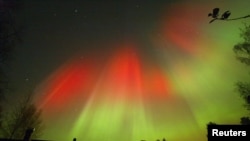Powerful winds from the sun affect the earth’s atmosphere. These solar winds cause the beautiful aurora borealis, also known as the northern lights. These winds are also responsible for many of the power outages that affect modern electrical systems.
The sun’s energy creates light and heat. It also produces charged electrical particles and magnetic fields. The sun can keep the earth nice and warm and helps our crops to grow. But a sudden burst of that solar energy can cause a power outage. William Murtagh is with the National Space Weather Prediction Center in Boulder, Colorado.
“As recently as 2003, a big geomagnetic storm during that period we call the Halloween Storms produced a blackout in Malmo, Sweden, the city of Malmo, Sweden and damaged transformers in the Escombe Network in South Africa.”
The National Space Weather Prediction Center is part of NOAA, the National Oceanic and Atmospheric Administration. The Prediction Center provides continually up-to-date forecasts to power companies, government agencies, the satellite industry and airline companies. It even shares these reports with users of global positioning system equipment.
The normal solar forecast is hot, sunny and worry-free. But sometimes satellites near the sun observe huge orange geysers. These explosions can produce magnetized winds, which continue into space. A solar storm generally takes at least half a day to reach the earth. So at first, says William Murtagh, the Prediction Center describes the solar activity as a “watch.”
“So a geomagnetic storm watch is somewhat like a hurricane watch when there’s hurricane sitting off shore of Miami and it’s a couple of days out.”
In the final hour of its trip to earth, the storm passes a special satellite orbiting our planet. The satellite provides new clues about the power and size of the storm. Then scientists hurry to send the latest information.
“So we can give all the folks that we gave a heads-up to a day or two earlier, we can say okay, it’s worse than we expected, it’s as expected, or maybe it’s a bit of a dud and is not going to be the impact we thought it might have here on Earth.”
Most storms are uneventful, or a bit of a dud, as he said. For larger storms, electric companies can direct power away from sensitive equipment and intense geomagnetic activity. But short-term outages are still possible. That is why hospitals, airports and other emergency centers are urged to keep back-up power generating equipment.
But predictions might not help us through a super solar storm. William Murtagh describes what has been called the 1859 Carrington Event. It created Aurora lights that were seen all over the world. The storm affected telegraphs -- the main electrical device of the time.
“I mean, what does that translate to, in our critical infrastructure, especially the power grid? That’s what we’re trying to understand now.”
Researcher Scott McBride sends geomagnetic currents through high voltage transformers. During most storms, he says, technicians could study individual pieces of equipment to reduce the chance that they will be damaged. But if a Carrington-sized event hit today, it could affect a very large area.
During a big storm, he predicts, current loads would fluctuate – or rise and fall. He thinks that these fluctuating loads would destroy many transformers and that it would take a long time to replace them.
Scott McBride says engineers are developing a transformer that could replace damaged equipment in days, not months. And modern grounding systems can protect equipment. But these steps will cost time and money.
So what if the Space Weather Prediction Center found a strong likelihood of another Carrington Event? Mr. McBride says there is one more back-up plan.
“Turning the power grid off would certainly protect it from a geomagnetic disturbance, but the socioeconomic impacts of de-energizing the power grid are so huge, it would be very difficult for somebody to actually make that decision.”
The experts say world leaders, power companies and major power users should start planning now so the world can weather a solar super storm.
I’m Anne Ball.
This report was based on a story from reporter Shelley Schlender in Colorado. George Grow wrote it for Learning English. The editor was Kelly Jean Kelly.
______________________________________________________________
Words in this Story
atmosphere – n. the gases surrounding any star or planet
burst – n. an unexpected explosion; v. to break open suddenly
continually – adv. repeated in the same way
equipment – n. things, tools or machines needed for a purpose or activity
device – n. a piece of equipment made for a special purpose
Now it’s your turn to use these Words in this Story. In the comments section, write a sentence using one of these words and we will provide feedback on your use of vocabulary and grammar.







